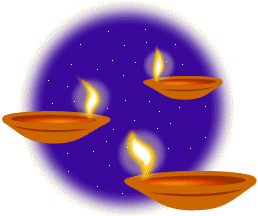口语Festival素材:Diwali(排灯节)
文章作者 无名 发表时间 2004:12:06 06:05:03
来源 100Test.Com百考试题网
| Diwali |
| October 26th |
| Diwali symbolizes the victory of light over darkness. Celebrated joyously all over the country, it is a festival of wealth and prosperity.
Dipavali means a row of lights (Diwali is simply a corrupt form of it) and the festival is so called because of the illuminations that mark the celebrations.
King Harsha described it as Dipapratipadotsava and King Bhoja calls it Sukharati (happy night) and describes how Lakshmi was venerated and worshipped at dusk and lamps lit in her honour on roadsides and river banks, on hill and tree, in home and temple. To Jimutavahana it was the vow of a happy night (Sukharatrivarta) Another legend speaks of how Bali was deprived of his kingdom by Vishnu on this day. The good Daitya king, through austerities and devotion, had defeated the great Indra himself. The gods thus feeling humbled appeal to Vishnu for protection. Vishnu becoming manifest in his Dwarf incarnation (Vamana) begs Bali for as much land as he (Vishnu) can over in three steps. Having obtained the boon, Vishnu covers heaven and earth in two strides and would have covered the world in the third, but then respecting Balis goodness and generosity, he stopped short and left the nether world to the Datiya king. The legend, found in Rig-Veda, tells of Vishnus three strides-over earth, heaven and the nether world of Patala, symbolizing apparently the rising, culmination and setting of the sun. A zodiacal allegory couched in mythological terms, it points to the setting of the light of the sun and the emergence of the darkness associated with the lower realm. Changes of season, of course, but it tells of the heart of a people and their unlimited delight in life, in light, burning not outside but in the deeper recesses of the nether regions of cosmos and man. Why else should folk recall Bali and his reign on this day? We learn that in Maharashtra, effigies of Bali in rice-flour and cow-dung are prepared by womenfolk who worship and invoke his blessings. Skanda Purana also refers to Bali being worshipped with fruits and flowers on this auspicious day by drawing this image on the ground in different hues. |
相关文章
10月30日北京口语回忆
口语Festival素材:Saint Lucias Day(瑞典圣露西亚节)
口语Festival素材:Veterans Day(美国老兵纪念日)
口语Festival素材:Halloween(万圣节)
口语Festival素材:Diwali(排灯节)
口语Festival素材:The Double Ninth Festival(重阳节)
10月24日北京雅思口语回忆
10/30日上海雅思口语回忆
口语Festival素材:United Nations Day(联合国日)
澳大利亚华人论坛
考好网
日本华人论坛
华人移民留学论坛
英国华人论坛
 The essence of this light is Shri Lakshmi-arising, at the beginning of time, out of the waters at the churning of the Milky Ocean by gods and demons for a thousand years. Regarded as the goddess of love, beauty and prosperity, Lakshmi, Kamla or Padma (Sanskrit words for lotus), the beloved consort of Vishnu, along with the dearly loved pot-bellied, elephant headed, auspicious god of the Hindu theogony, Siri Ganesha, is a presiding deity of the festival of lights. They are worshipped in every household so that the year may be full of prosperity. Throughout the night a lamp is kept burning before her image so that she may continue to dwell in the house and bestow upon it the wealth of life.
The essence of this light is Shri Lakshmi-arising, at the beginning of time, out of the waters at the churning of the Milky Ocean by gods and demons for a thousand years. Regarded as the goddess of love, beauty and prosperity, Lakshmi, Kamla or Padma (Sanskrit words for lotus), the beloved consort of Vishnu, along with the dearly loved pot-bellied, elephant headed, auspicious god of the Hindu theogony, Siri Ganesha, is a presiding deity of the festival of lights. They are worshipped in every household so that the year may be full of prosperity. Throughout the night a lamp is kept burning before her image so that she may continue to dwell in the house and bestow upon it the wealth of life. Every Hindu home, rich or poor, it given a spring cleaning a few days prior to the auspicious day, whitewashed and adorned in a festive way. Rows of little earthen lamps illuminate terraces and gardens, walls and courtyards, outer and inner precincts of a temple or a palace. That it was so from ancient times is borne by kings and travelers who have recorded the celebrations.
Every Hindu home, rich or poor, it given a spring cleaning a few days prior to the auspicious day, whitewashed and adorned in a festive way. Rows of little earthen lamps illuminate terraces and gardens, walls and courtyards, outer and inner precincts of a temple or a palace. That it was so from ancient times is borne by kings and travelers who have recorded the celebrations.